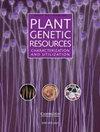Genetic diversity of Greek grapevine (Vitis vinifera L.) cultivars using ampelographic and microsatellite markers
IF 0.7
4区 生物学
Q3 PLANT SCIENCES
Plant Genetic Resources: Characterization and Utilization
Pub Date : 2022-12-01
DOI:10.1017/s147926212200020x
引用次数: 1
Abstract
Grapevine (Vitis vinifera L.) is a major worldwide crop of high economic importance, tightly interwoven with the traditions and the culture of many civilizations. The Greek vineyard is one of the oldest in the world composed of an ample number of highly diverse indigenous landraces. However, over the last decades the local cultivated grapevine germplasm has undergone a drastic reduction of diversity, due to the established market preferences for international varieties. In the current work a combined approach involving both, ampelographic traits and microsatellite markers has been undertaken, to study the genetic diversity within and among 96 grapevine genotypes belonging to 36 V. vinifera subsp. vinifera cultivars, predominantly representing autochthonous Greek landraces. Results revealed high genetic diversity for the Greek cultivars yielding a mean number of alleles per locus 14.69 and mean polymorphic information content 0.848. Hierarchical cluster analysis, employing both, ampelographic and microsatellite data, showed a clear distinction based on the origin of the germplasm; Anatolian versus Mediterranean. Principal component analysis, based on the most informative ampelographic traits, coupled to the results from genetic structure analysis further corroborated the proposal of germplasm differentiation on the basis of geographic origin. This information can be further utilized for the reconstitution of the Greek vineyard and can significantly contribute towards a rational conservation and utilization strategy for breeding or for direct cultivation of the Greek indigenous grapevine germplasm.葡萄栽培品种的遗传多样性及微卫星标记
葡萄藤(Vitis vinifera L.)是世界范围内重要的经济作物,与许多文明的传统和文化紧密交织在一起。希腊葡萄园是世界上最古老的葡萄园之一,由大量高度多样化的本土种族组成。然而,在过去的几十年里,由于市场对国际品种的偏好,当地种植的葡萄种质资源的多样性急剧减少。在目前的工作中,采用了一种结合两种方法,包括灌肠性状和微卫星标记,研究了葡萄属36个葡萄亚种的96个葡萄基因型内部和之间的遗传多样性。葡萄栽培品种,主要代表希腊本土品种。结果表明,希腊品种具有较高的遗传多样性,每个位点平均等位基因数为14.69个,平均多态性信息含量为0.848个。利用光谱和微卫星数据进行的聚类分析显示,不同来源的种质间存在明显的差异;安纳托利亚vs地中海。主成分分析和遗传结构分析结果进一步证实了以地理来源为基础的种质分化理论。这些信息可以进一步用于希腊葡萄园的重建,并可以为希腊本土葡萄种质资源的合理保护和利用策略或直接栽培做出重大贡献。
本文章由计算机程序翻译,如有差异,请以英文原文为准。
求助全文
约1分钟内获得全文
求助全文
来源期刊

Plant Genetic Resources: Characterization and Utilization
Agricultural and Biological Sciences-Agronomy and Crop Science
CiteScore
2.80
自引率
0.00%
发文量
29
审稿时长
>12 weeks
期刊介绍:
Plant Genetic Resources is an international journal which provides a forum for describing the application of novel genomic technologies, as well as their integration with established techniques, towards the understanding of the genetic variation captured in both in situ and ex situ collections of crop and non-crop plants; and for the airing of wider issues relevant to plant germplasm conservation and utilisation. We particularly welcome multi-disciplinary approaches that incorporate both a technical and a socio-economic focus. Technical aspects can cover developments in technologies of potential or demonstrated relevance to the analysis of variation and diversity at the phenotypic and genotypic levels.
 求助内容:
求助内容: 应助结果提醒方式:
应助结果提醒方式:


